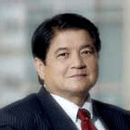Thursday, April 18, 2024
News and Views from the Global South
Dubai 1977, Dubai Now
- Christmas of 1976 was a turning point in my life. It was the afternoon that Sultan Khalifa of Dubai personally met me at the Mandarin Hotel. He said that His Highness Sheikh Rashid bin Saeed Al Maktoum, the ruler of Dubai, had sent him around the world to look for planners to help plan, design, and develop Dubai and transform it from the Third World to the First.
While Sultan Khalifa was presenting the goals and vision for the development of Dubai, in my mind, I was thinking about what would I do in Dubai. Back then, Manila was probably 50 years ahead of Dubai in terms of infrastructure, paved roads, transportation and airports. Today, the Philippines is probably about 50 to 100 years behind Dubai in terms of planning and infrastructure.
During the conversation, one thing that Sultan Khalifa said stood out, as these were the specific instructions of the late founder of “Modern Dubai,” His Highness Sheikh Rashid bin Saeed Al Maktoum. “Design Dubai as if there is no oil. Plan a city for two million people (in 1977 the population was 270,000). Create a garden city out of the desert. Travel around the world and take the best practices that we can adopt. Make Dubai a pacesetter city in the Middle East and North Africa in 15 years; bring Dubai from the Third to the First World.”
After finishing the MMETROPLAN, I went to Dubai and brought with me the envisioned Metro Manila as one of the models for the emirate city. I was the only Southeast Asian and Filipino, and I brought with me my family. My daughter, Karima, was the first Filipino born in Dubai.
Looking back today, after 40 years, what has happened to Dubai?
What I learned from Dubai
It only takes one generation to transform a country. The first instruction of His Highness Sheik Rashid bin Saeed Al Maktoum was to travel around the world to copy and take inspiration from the best practices of First World cities and countries. He said: “Dubai will run out of oil, design Dubai as if there is no oil.” So, we needed to find models that would make Dubai globally competitive in other industries and non-dependent on oil. My colleagues went to the more famous cities: London, Paris, and New York. I, on the other hand, visited the new emerging fastest growing cities which became First World in less than 15 years. I went to cities such as San Francisco, Hong Kong, Zurich, Singapore and Geneva. From these so-called instant cities, my colleagues and I adapted and copied the global best practices, and learned from their mistakes.
In 1977, the population of Dubai was only 200,000. But the instruction we were instructed to design Dubai to accommodate two million people as well as build mega airport and mega seaports. By the 1980s Dubai was building seaports for the ships that were never built, airports for the tourists and industries that were yet to come. We were importing garden soil from Pakistan, irrigation from Germany, and flowers from Holland. Dubai quickly became a garden in the desert. Today, it has more landscaping than Metro Manila. In less than eight years, the Dubai port became one of the most important ports in the region, most especially during the Gulf War.
Five types of infrastructure
There are five types of infrastructure, and Dubai had adopted all. These are soft (ease of doing business and policies), hard (roads and highways), progressive (mass transport, airports and seaports), institutional (government centers and places for institutional memory and continuity), and green/sustainable infrastructure.
The ruler of Dubai told us that, “what is good for business is good for Dubai”. He emphasized the importance of the ease of doing business. The permits should be signed immediately; if there are objections from the council, they have two weeks to explain why it will not be signed. Government offices also avoided having desks with drawers, and conversations should be kept short. Today, it is encouraged for all permits be done electronically so that everything is well-documented.
Five ingredients of development success
Whenever I share inspirations from other countries, many will downplay the possibilities. Some will say that the Philippines is different, that won’t work, etc. But a good question to ask is, have we ever tried? A friend of mine said that the problem for some Filipinos is that for every solution that you suggest they will find problems.
After my experience in Dubai, I was inspired to come home to the Philippines during the mid-1980s. I saw the possibilities; in terms of resources, the quality of education and current infrastructure then, the Philippines had more than enough to become a First World nation. But I believe that the Philippines still has the chance!
After visiting more than 2,000 cities in 67 countries, and having worked in 39 countries, I have come to the conclusion that there are five ingredients of successful cities: visionary leadership, strong political will, good planning, good design, and good governance.
Let us learn from Dubai, and from global best practices.
This story was originally published by The Manila Times, Philippines

 Print
Print




